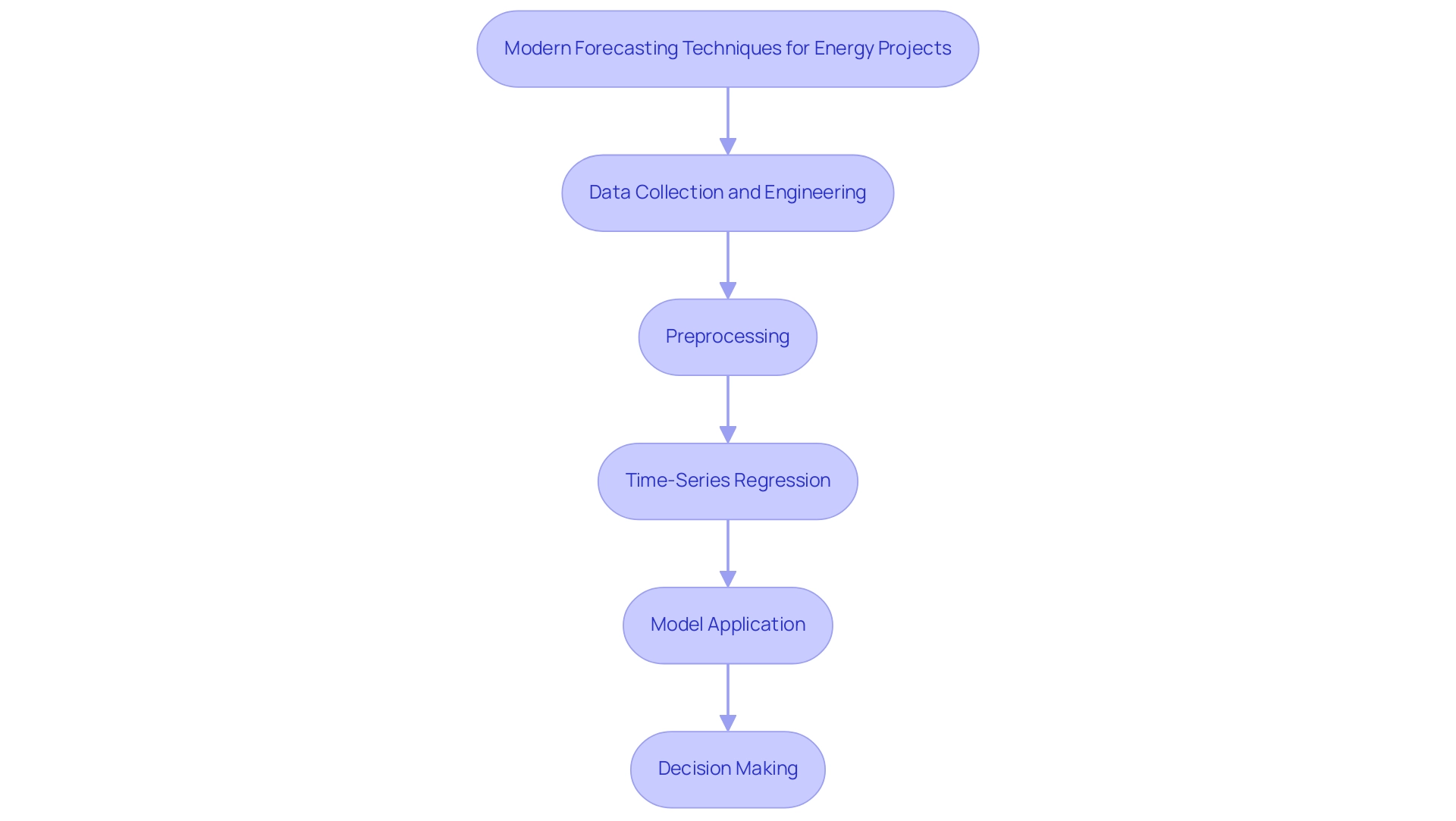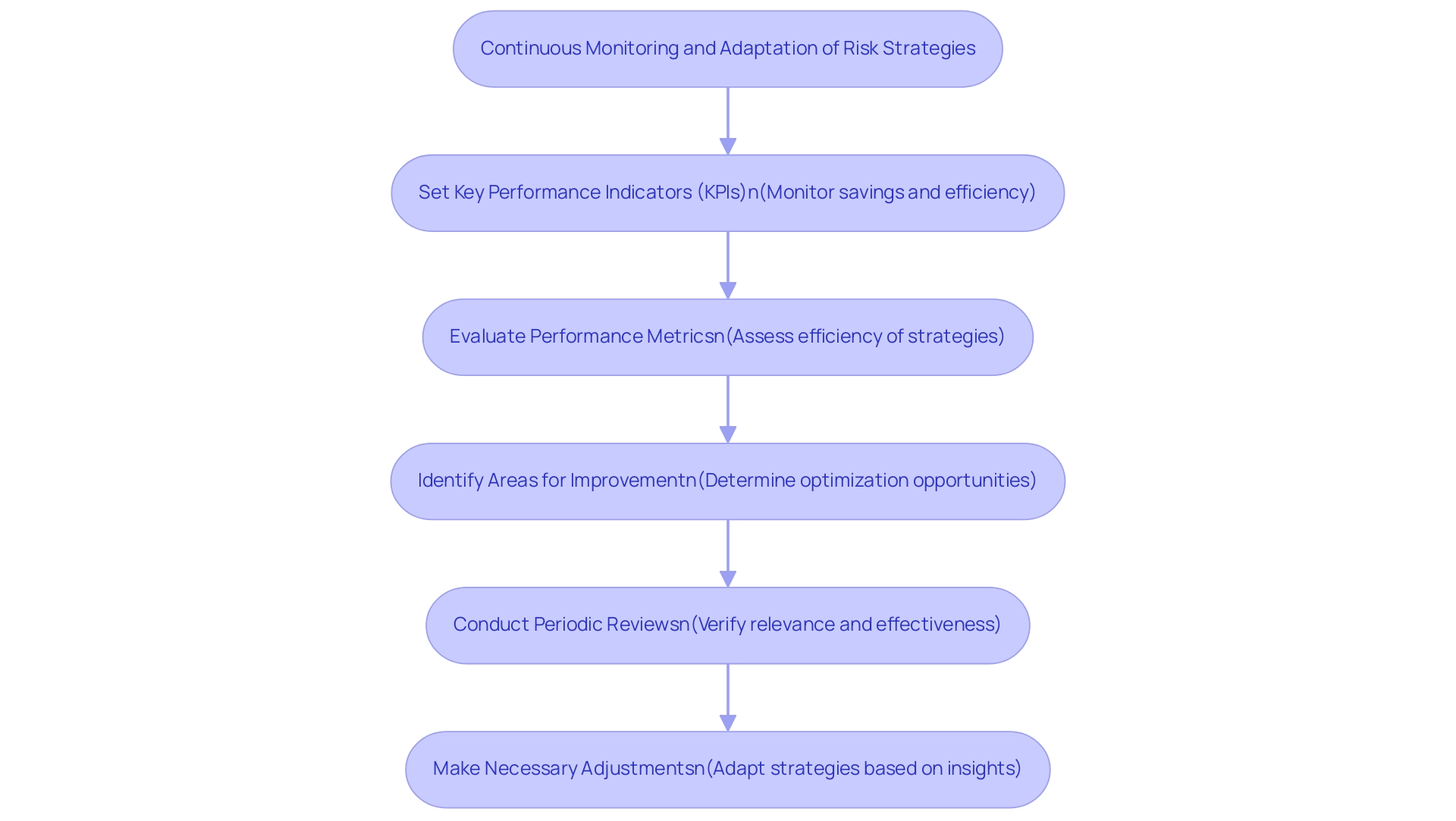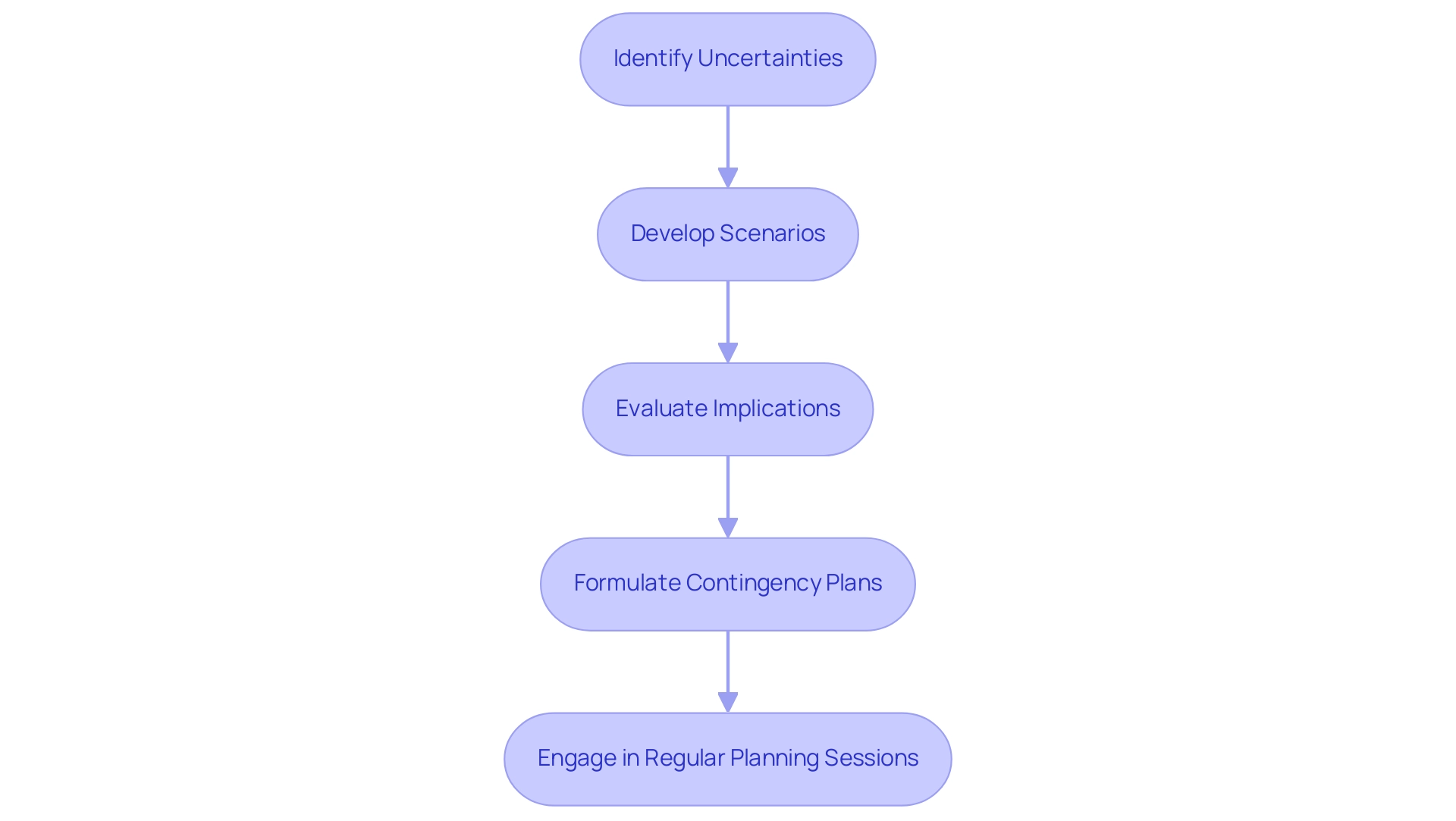Overview
Best practices for risk forecasting in energy projects involve utilizing modern forecasting techniques like marine forecasting, predictive analytics, and scenario planning to enhance decision-making and mitigate uncertainties. The article supports this by detailing how advanced models and stakeholder engagement improve planning accuracy and operational efficiency, ultimately enabling organizations to navigate regulatory challenges and optimize project outcomes.
Introduction
In the rapidly evolving energy sector, the integration of modern forecasting techniques and risk management strategies has emerged as a critical factor for success, particularly within offshore wind projects. As organizations strive to enhance project outcomes and navigate regulatory complexities, the adoption of advanced methodologies such as:
- Marine forecasting
- Predictive analytics
- Scenario planning
becomes paramount. These innovative approaches not only improve the precision of project planning but also empower teams to proactively identify and mitigate potential risks. By leveraging sophisticated data analytics and engaging stakeholders effectively, energy companies can foster resilience and adaptability, ensuring they remain competitive in a landscape characterized by uncertainty and change.
This article delves into the transformative impact of these techniques on the energy sector, highlighting their significance in optimizing project performance and enhancing operational efficiency.
Harnessing Modern Forecasting Techniques for Energy Projects
The energy sector, especially in the area of offshore wind initiatives, is experiencing a transformative shift driven by risk forecasting for energy projects and the adoption of modern forecasting techniques. Marine Forecasting, utilizing sophisticated meteorological models and satellite data, significantly contributes to risk forecasting for energy projects and enhances the accuracy of planning and risk management. For instance, advanced weather prediction models have demonstrated their capacity to mitigate unforeseen delays, thereby optimizing scheduling processes.
Additionally, the integration of Geographic Information System (GIS) tools empowers teams to visualize potential sites effectively, enhancing decision-making related to risk forecasting for energy projects and environmental assessments. The recent methodological flow for energy forecasting is crucial for risk forecasting for energy projects, encompassing critical steps such as:
- Data collection and engineering
- Preprocessing
- Time-series regression
to ensure a robust foundation for planning. A notable statistic in this context is the mean absolute percentage error (MAPE), which is minimized through the use of genetic algorithms (GA) for optimizing forecasting coefficients.
Furthermore, Liu et al. developed an ensemble model for wind speed multi-step forecasting, exemplifying the application of modern forecasting techniques in offshore wind initiatives. Investing in training for teams to leverage these technologies is essential, as it facilitates a proactive approach to managing uncertainties.
The case study on short-term power load forecasting illustrates the impact of combining CNN, LSTM, and attention mechanisms, leading to remarkable improvements in accuracy for thermal power units. This underscores the vital role of modern forecasting techniques, particularly risk forecasting for energy projects, in optimizing offshore wind project outcomes, ultimately enhancing the industry's ability to navigate regulatory compliance and operational challenges. As John Tukey aptly noted, there is a pressing need for more integration between graphical analysis and descriptive measures, further emphasizing the importance of these modern methodologies.

Leveraging Predictive Analytics and AI for Enhanced Risk Forecasting
The incorporation of predictive analytics and artificial intelligence (AI) into risk forecasting for energy projects signifies a major advancement in the power industry. By leveraging historical data and discerning patterns, organizations can enhance overall operational efficiency through risk forecasting for energy projects, allowing them to proactively identify and mitigate potential risks. For instance, sophisticated predictive models are capable of analyzing fluctuations in power prices and demand, which empowers companies to make strategic decisions about resource allocation.
Furthermore, AI enhances supply chain optimization by forecasting potential disruptions, allowing for pre-emptive actions that minimize service interruptions. A compelling illustration of this is the Hawaiian Electric Company (HECO), which has invested in smart grid technologies and predictive analytics to bolster grid reliability against extreme weather events. By monitoring real-time grid conditions and forecasting potential disruptions, HECO has significantly improved grid reliability and reduced downtime.
Notably, the United States has completed 128 million smart meter deployments by the end of 2023, reflecting a broader trend towards modernization in utility infrastructure. Additionally, advancements such as Xylem's Stratus IQ+ smart electricity meter provide utilities with enhanced data capabilities, including EV charging information, which supports effective predictive analytics. However, it is crucial to recognize that while specialized data tools, such as resource control systems and geographic information systems, address particular industry demands, they often necessitate expert knowledge, restricting their adaptability and applications.
To fully harness the advantages of predictive analytics, utility companies should prioritize investments in advanced data handling systems that enhance risk forecasting for energy projects through comprehensive data collection and analysis, ensuring their forecasting practices are both robust and adaptable to evolving market dynamics.
Establishing a Robust Risk Management Framework
Creating a strong management framework is crucial for the success of energy projects, especially in the context of risk forecasting for energy projects and navigating the complexities of regulatory compliance. A comprehensive threat evaluation is the first step in risk forecasting for energy projects, allowing organizations to identify potential dangers spanning financial, regulatory, and environmental domains. Involving stakeholders is essential during this stage; varied viewpoints improve the depth of insights and guarantee that all possible challenges are taken into account.
After identification, threats should be prioritized based on their potential impact and likelihood. Implementing effective mitigation strategies—such as contingency planning and regular monitoring—supports risk forecasting for energy projects and enables organizations to manage threats proactively. One effective strategy is the use of granular modeling techniques, which can reduce exposure to rare weather events by up to 60%, enhancing negotiation power for insurance terms.
Furthermore, the case study titled "Contribution of Renewable Energy to Resilience" illustrates how renewable energy, particularly solar energy, enhances resilience by allowing for the storage and use of electricity generated from sunlight, thus reducing dependency on fuel deliveries necessary for conventional emergency backup power systems. Furthermore, it is essential to recognize the obstacles to effective hazard oversight in areas like Iraq's construction sector, where the absence of a safety team, inadequate planning, and insufficient training impede progress. Nurturing a culture that acknowledges threats within the organization motivates team members to actively report dangers and engage in continuous threat oversight efforts.
As emphasized by Bertrand Ntwari,
This study tackles this empirical gap and evaluates the degree to which uncertainty handling practices influence initiatives’ performance, highlighting that a well-organized uncertainty handling framework not only improves initiative resilience but also aids in overall effectiveness.
With private funding playing a crucial role in providing power access to over 770 million individuals worldwide, the stakes are high for organizations to develop thorough management strategies that support successful initiative implementation.
Engaging Stakeholders Effectively
Successful involvement of stakeholders is crucial for risk forecasting for energy projects, which helps in reducing uncertainties. Developing a comprehensive stakeholder engagement plan is crucial, encompassing all relevant parties such as local communities, government agencies, and environmental groups. By promoting open communication, companies can establish trust and motivate stakeholders to voice their concerns, which may aid in risk forecasting for energy projects by uncovering potential risks early in the lifecycle.
A study examining 1,119 instances of stakeholder engagement in resource management, including clean energy, highlights the significance of these interactions in achieving successful results. Regular updates and feedback sessions are vital for maintaining stakeholder interest and support throughout the initiative. Additionally, leveraging digital platforms for engagement enhances communication efficiency and transparency, ultimately contributing to smoother execution and effective risk forecasting for energy projects.
A novel Impact Assessment Framework for Public Engagement has been created to assess the effectiveness of such engagement strategies in infrastructure projects. This framework defines nine key impact criteria—such as inclusiveness, timing of engagement, and trust—that can guide companies in refining their stakeholder engagement processes. Additionally, as mentioned by Tesla, "Tesla’s venture into renewable storage has prompted traditional companies to investigate similar solutions."
This highlights the need for innovative communication strategies that resonate with stakeholders and adapt to evolving industry trends. By implementing these best practices, companies can navigate the complexities of regulatory compliance and foster positive relationships with the communities they serve.
Continuous Monitoring and Adaptation of Risk Strategies
The ongoing assessment and adjustment of strategies are vital for organizations to stay flexible within the constantly changing environment of power initiatives. Setting key performance indicators (KPIs) is essential for evaluating the efficiency of mitigation strategies on a regular basis. These KPIs serve as benchmarks that guide organizations in evaluating their performance and identifying areas for improvement.
For example, the initiative at Tallaght University Hospital showcased the considerable advantages of efficient monitoring, leading to nearly USD 1 million in savings each year. The incorporation of real-time data analysis into project management enables organizations to monitor performance metrics and identify emerging challenges efficiently. A recent example illustrates this; one factory saved INR 20,000 monthly by optimizing power usage in specific areas through data analytics.
Such insights are invaluable for timely decision-making. Conducting periodic reviews of risk forecasting for energy projects is critical to verify their relevance and effectiveness, facilitating necessary adjustments in response to unforeseen challenges. This adaptive method not only improves resilience but also enables organizations to take advantage of new opportunities, ultimately aiding in a more sustainable future.
As emphasized by industry specialists, the aim is to double the global average yearly rate of efficiency enhancements by 2030, highlighting the necessity for continuous oversight and adjustment in initiatives. Furthermore, the case study on Remote Power Consumption Monitoring highlights the implementation and challenges of contemporary technologies in resource monitoring, further demonstrating the necessity for proactive hazard management practices, which are essential for risk forecasting for energy projects. In India, the share of green leases in the office market has risen to 16% as part of a post-pandemic focus on sustainability, reinforcing the importance of these strategies.

Utilizing Scenario Planning for Risk Preparedness
Scenario planning serves as a crucial approach for enhancing preparedness against uncertainties within the context of risk forecasting for energy projects. By conceptualizing a spectrum of future scenarios—from optimal conditions to potential crises—organizations gain valuable insights into the implications of diverse risks. According to recent studies, organizations that implement scenario planning see a 30% increase in their ability to respond effectively to regulatory changes and crises.
This forward-thinking methodology equips teams to formulate contingency plans that are finely tuned to particular scenarios, thereby enhancing readiness for various outcomes. For instance, risk forecasting for energy projects allows energy firms to examine the ramifications of regulatory changes or environmental calamities on timelines and financial implications. Regularly engaging in scenario planning sessions cultivates a culture of strategic foresight among project teams, empowering organizations to navigate uncertainties with heightened confidence and agility.
As Chandana Janaswamy, a Master's student in Business-Management at UC Business School, points out, 'This is a very good article. Just wondering about dealing with uncertainties in long-term strategic planning and how frequently we need to refine our strategic decisions to overcome those uncertainties in scenario outcomes.' This highlights the ongoing need for adaptability in strategic planning.
Furthermore, the case study titled 'Conclusion on Scenario Planning' illustrates how organizations can foster adaptability and resilience through effective scenario planning, which is crucial for risk forecasting for energy projects, empowering them to proactively shape their future. As highlighted in a recent workshop by the North Pacific Fishery Management Council, the implementation of scenario planning is integral for organizations aiming to develop robust short- and long-term management strategies in the face of evolving challenges.

Conclusion
The integration of modern forecasting techniques, predictive analytics, and robust risk management strategies is transforming the energy sector, particularly within offshore wind projects. By employing marine forecasting and advanced data analytics, organizations can significantly enhance project planning, mitigate risks, and improve operational efficiency. The use of sophisticated models and tools not only allows for better decision-making but also empowers teams to proactively address potential challenges, thus fostering resilience in a rapidly changing landscape.
Furthermore, the establishment of a comprehensive risk management framework is essential for navigating regulatory complexities and ensuring successful project implementation. Engaging stakeholders effectively enhances transparency and trust, which are crucial for identifying and mitigating risks early in the project lifecycle. Continuous monitoring and adaptation of risk strategies, supported by scenario planning, enable organizations to remain agile and responsive to emerging challenges and opportunities.
In conclusion, the successful application of these methodologies not only optimizes project performance but also strengthens the overall resilience of energy companies. As the industry continues to evolve, embracing these innovative approaches will be vital for maintaining competitiveness and achieving sustainable growth in the face of uncertainty. The future of energy projects hinges on the ability to harness these tools effectively, ensuring that organizations are well-prepared to meet the demands of an increasingly complex environment.
Frequently Asked Questions
What is driving the transformative shift in the energy sector, particularly in offshore wind initiatives?
The shift is driven by risk forecasting for energy projects and the adoption of modern forecasting techniques, including Marine Forecasting, which utilizes sophisticated meteorological models and satellite data.
How does Marine Forecasting contribute to risk management in energy projects?
Marine Forecasting enhances the accuracy of planning and risk management by mitigating unforeseen delays through advanced weather prediction models, thereby optimizing scheduling processes.
What role do Geographic Information System (GIS) tools play in energy project risk forecasting?
GIS tools empower teams to visualize potential sites effectively, which enhances decision-making related to risk forecasting and environmental assessments.
What are the critical steps in the recent methodological flow for energy forecasting?
The critical steps include data collection and engineering, preprocessing, and time-series regression, which ensure a robust foundation for planning.
How is the mean absolute percentage error (MAPE) minimized in forecasting?
MAPE is minimized through the use of genetic algorithms (GA) for optimizing forecasting coefficients.
Can you provide an example of modern forecasting techniques applied in offshore wind initiatives?
Liu et al. developed an ensemble model for wind speed multi-step forecasting, demonstrating the application of modern forecasting techniques.
Why is investing in training for teams important in the context of risk forecasting?
Investing in training is essential as it enables teams to leverage modern technologies effectively, facilitating a proactive approach to managing uncertainties.
What impact do modern forecasting techniques have on thermal power units?
The combination of CNN, LSTM, and attention mechanisms in short-term power load forecasting has led to significant improvements in accuracy for thermal power units.
How does predictive analytics and artificial intelligence (AI) enhance risk forecasting in the energy sector?
Predictive analytics and AI allow organizations to analyze historical data and discern patterns, enhancing operational efficiency and enabling proactive risk identification and mitigation.
What is a practical example of predictive analytics improving grid reliability?
The Hawaiian Electric Company (HECO) has invested in smart grid technologies and predictive analytics to monitor real-time grid conditions and forecast disruptions, significantly improving grid reliability.
What trend is reflected by the completion of 128 million smart meter deployments in the U.S. by the end of 2023?
This trend reflects a broader move towards modernization in utility infrastructure, enhancing data capabilities for effective predictive analytics.
What should utility companies prioritize to fully harness the advantages of predictive analytics?
Utility companies should prioritize investments in advanced data handling systems that enhance risk forecasting through comprehensive data collection and analysis, ensuring adaptability to evolving market dynamics.
List of Sources
- Harnessing Modern Forecasting Techniques for Energy Projects
- mdpi.com (https://mdpi.com/1996-1073/17/14/3480)
- mdpi.com (https://mdpi.com/1996-1073/17/7/1662)
- Leveraging Predictive Analytics and AI for Enhanced Risk Forecasting
- Big Data Analytics Market In Energy Sector Market Size | Mordor Intelligence (https://mordorintelligence.com/industry-reports/big-data-in-energy-sector-industry)
- Harnessing the power of visual data science in the energy sector - Spotfire Blog (https://spotfire.com/blog/2024/11/21/harnessing-the-power-of-visual-data-science-in-the-energy-sector)
- Boosting grid reliability using predictive analytics and AI (https://polesaver.com/blog/boosting-grid-reliability-predictive-analytics-and-ai)
- Establishing a Robust Risk Management Framework
- From Risk to Resilience: Renewable Energy Risk Management (https://contractpower.ai/renewable-energy-risk-management)
- A holistic risk management framework for renewable energy investments (https://sciencedirect.com/science/article/pii/S1364032122002210)
- (PDF) Risk Management Practices and Energy Projects' Performance (https://researchgate.net/publication/362156214_Risk_Management_Practices_and_Energy_Projects'_Performance)
- Engaging Stakeholders Effectively
- (PDF) Stakeholder engagement and influence: Strategies for successful energy projects (https://researchgate.net/publication/382514218_Stakeholder_engagement_and_influence_Strategies_for_successful_energy_projects)
- Stakeholder engagement in natural resources for energy transitions governance (https://sciencedirect.com/science/article/pii/S0195925523001725)
- ieecp.org (https://ieecp.org/publications/impact-assessment-of-case-studies-assessing-the-impacts-of-public-engagement-in-energy-infrastructure-projects)
- Understanding Stakeholders in the Energy and Public Utilities sector (https://boreal-is.com/blog/stakeholders-in-energy-and-utilities-sector)
- Continuous Monitoring and Adaptation of Risk Strategies
- Energy Efficiency Progress Tracker – Data Tools - IEA (https://iea.org/data-and-statistics/data-tools/energy-efficiency-progress-tracker)
- Energy Monitoring and Savings: Harnessing Insights for a Greener Future (https://linkedin.com/pulse/energy-monitoring-savings-harnessing-insights-greener-future-fywoc)
- A survey of power-consumption monitoring systems (https://sciencedirect.com/science/article/pii/S2772671123002814)
- Utilizing Scenario Planning for Risk Preparedness
- The Power of Scenario Planning in Strategic Decision-Making (https://linkedin.com/pulse/power-scenario-planning-strategic-decision-making-saurav-goel-o8bff)
- Scenario Planning: A Tool for Climate-Informed Decision Making (https://fisheries.noaa.gov/national/climate/scenario-planning-tool-climate-informed-decision-making)




